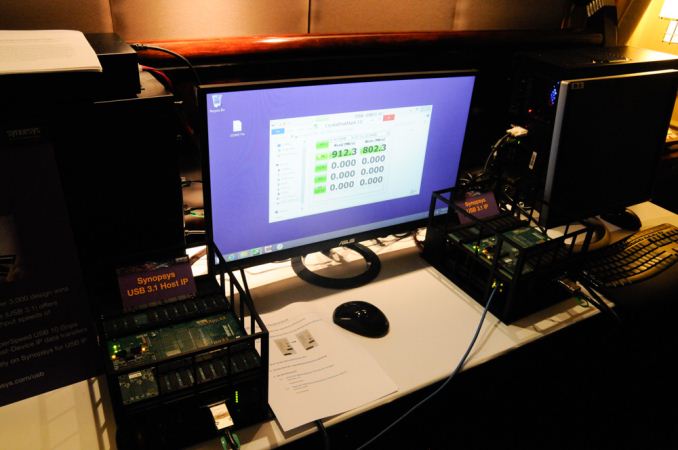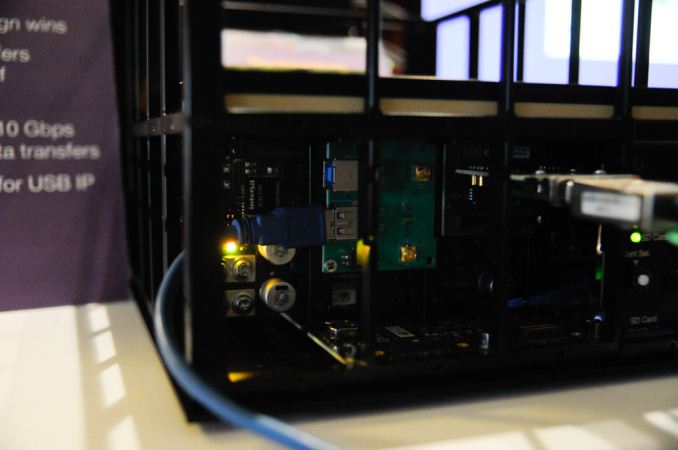USB-IF Updates Us on Type C Connector, Demonstrates USB SuperSpeed 3.1 Transfers
by Brian Klug on January 7, 2014 2:36 PM EST- Posted in
- Trade Shows
- CES
- USB-IF
- CES 2014
- USB 3.1

December of last year, the USB-IF announced that the definition of a new type of compact connector, dubbed type C, was underway. After pushback from the USB 3.0 micro-B connector, which added a lobe for the USB 3.0 data lines in addition to the signaling and port for USB 2.0 micro-B, many saw the definition of a type C connector as a way to learn from previous lessons and design a connector for better, sleeker industrial designs and with a new emphasis on mobile devices like tablets and smartphones.
The type C connector is still in development, and there aren't any current renderings or drawings, but what has been laid out are the design goals for the new connector design. The connector will be reversible, and able to negotiation which end is host or client (direction-agnostic) with type c connectorization at both ends, although cables will still come in type-A to type-C combinations for use with power adapters and current generation hosts. In addition it will be around the same size as the current USB 2.0 Micro-B connector and catered toward enabling the kinds of thin and sleek industrial designs smartphone, tablet, and even notebook OEMs desire. Type C will work with USB 3.1 and the power delivery specification, in addition to including some extra pins for growth and building out the standard in the future, the goal is to make this the connector for the next 10 years. In addition, the standard will define an intermediary adapter for going from current 2.0 or 3.0 micro-B connectors to the new type C connector. I'm told to expect the Type C connector to have drawings and be better understood probably before the next IDF.
In addition USB-IF showed two demos of USB 3.1, the new standard which enables up to 10 Gbps transfer speeds by doubling the clock rate and also moving to a more efficient 128b/132b coding scheme with just 3 percent overhead, compared to the 20% overhead in 10b/8b from USB 3.0. Both demos were implemented on FPGAs, and showed transfer rates right around 1 GB/s (8 Gbps), the second using Synopsis' FPGA implementation over current generation USB 3.0 cables.
















31 Comments
View All Comments
SunLord - Tuesday, January 7, 2014 - link
I can't think of a single way USB3.0 would ever be able to beat or even be on the same playing field as eSATA when it comes to data transfer given the massive difference in speed they offerSunLord - Tuesday, January 7, 2014 - link
I get that USB3.0 is rated at a theoretical 5Gbps vs sata 6Gbps but that doesn't really mean much when it comes to how the specs are designed to work compared to each other when transferring filesname99 - Wednesday, January 8, 2014 - link
The issue is not "theoretical" speed.The issue is that the speed you are talking about is a PHY speed --- the speed at which individual bits are clocked on the wire.
(a) Nothing in the spec says this speed has to be sustained. Early HW is allowed to (did with USB 2, and likely does with USB3) have buffers that are large enough to send or receive a single packet at this speed, but without the overall throughput that allows this to be sustained for multiple successive packets,
(b) The PHY rate is not the MAC rate. USB is a bus with possible multiple devices on it. There is some MAC protocol for deciding who gets control of the bus when. This protocol appears to be pretty inefficient (at least in the case of USB2) dropping about 25% of performance on the floor, and I would guess the USB3 MAC protocol is pretty much the same.
(c) Most USB drives use the older USB MSC protocol for communicating with the drive, not the newer UAS protocol which is supposed to allow for higher performance (by allowing things like NCQ commands to travel over the wire). This doesn't necessarily speed up bulk transfers, but if UAS allows for larger packets than does MSC (I don't know if this is true) it would allow for higher speed.
repoman27 - Tuesday, January 7, 2014 - link
I can think of a bunch. SuperSpeed USB and eSATA 6Gb/s have nominal data rates of 5 Gbit/s and 6 Gbit/s respectively, and both use 8b/10b encoding. Theoretically this gives eSATA 6Gb/s a 100 MB/s advantage, however, if the connected drive is the limiting factor because it can't exceed 440 MB/s (as is often the case) this advantage is irrelevant. If both ports are provided by discrete controllers that only have PCIe 2.0 x1 connections to the host (another common scenario), then eSATA's advantage once again disappears. In order to support 6Gb/s operation, the drive, enclosure (if you're using one) and port you're connecting to must all support 6Gb/s, otherwise the pendulum swings in favor of USB 3.0.Plugging a cheap USB 3.0 external that supports UASP into a SuperSpeed port provided by an Intel or AMD PCH/FCH is generally going to yield better performance than connecting a drive via eSATA to a port provided by a discrete controller, unless that controller has more than a PCIe 2.0 x1 back end, which would be a rarity on most motherboards. If the eSATA 6Gb/s port is provided by the chipset, it can put up a fight. However, UASP allows better use of the full-duplex channels provided by USB 3.0, and can actually reduce latency and protocol overhead compared to the still stuck on simplex SATA.
chekk - Wednesday, January 8, 2014 - link
Despite what the theoretical numbers say, the actual behavior is quite different and why I'm currently unhappy with USB3 for file transfers. The only case where I have ever personally seen USB3 beat eSATA in writes was in large file transfers from an SSD. If every other case, even eSATA 3Gb/s was much faster. Particularly with small files where USB3 got slower until it leveled off at about 20 MB/s whereas eSATA was 60MB/s plus. I tried this with and without turbo mode in the BIOS.Until I can see fast USB performance, I'll hang onto my external eSATA docks.
repoman27 - Wednesday, January 8, 2014 - link
I'm guessing you're either using a port supplied by a discrete USB 3.0 controller, not experiencing any UASP love, or both.Make sure whatever you are using for a SATA to USB 3.0 bridge supports UASP, plug directly into a USB 3.0 port provided by an Intel 7 or 8 series PCH or AMD A70M, A75 or A85X FCH with no intervening hubs and whatnot, and that you're running Windows 8/8.1.
A decent SSD connected via USB 3.0 to an Intel Z77 system can push 200 MB/s of small random reads/writes, which is comparable to any discrete eSATA 6Gb/s solution even at high queue depths.
Of course eSATA to SATA is still the only way to go for issuing an ATA secure erase command or updating firmware on most drives.
psychobriggsy - Wednesday, January 8, 2014 - link
There's still USB3.1, which will be out in the same timeframe as this connector is implemented in actual devices you can buy (2015).iaco - Tuesday, January 7, 2014 - link
That's what the USB Attached SCSI protocol is for. What I've read indicates UASP should close the gap between eSATA and USB. Unfortunately most USB 3 storage devices don't support it.HisDivineOrder - Wednesday, January 8, 2014 - link
Why do they always do this? They do it with HDMI. They do it with USB 2 and 3.Don't make a bajillion versions of the same standard. Make one cable and then stop. Oh, and making it reversible is always the right choice.
nightbringer57 - Wednesday, January 8, 2014 - link
I don't think that the engineers who developed USB in the mid-90s, mainly for small computer periphals like mice, keyboards, or plug-it-and-forget-it things like printers, had ultra-thin smartphones in mind when they designed the connector ;)And I prefer different mechanical connectors with a single universal interface rather than different interfaces. And backwards compatibility is quite handful.
And it is the same for HDMI. It was designed as a replacement for SCART/S-Video + audio connections. For TVs and stuff. It was not designed to be used with handheld device outputting full HD content, being constantly plugged on and off.
Of course, a single universal small connector is more practical. But I can understand that when people thought this connectors 10 to 20 years ago, they did not imagine what we would do with them now ;)